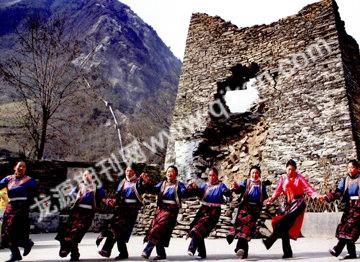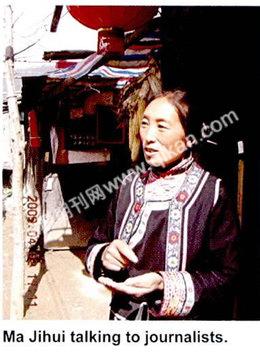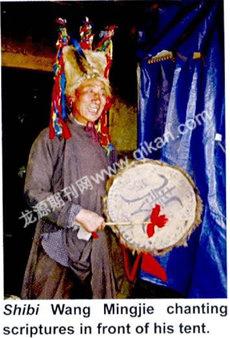Ethnic Qiang Culture Survives Earthquake
2009-06-19BystaffreporterZHANGHUA
By staff reporter ZHANG HUA

MA Jihui, 41, is bent over a piece of embroidery in front of her tent. In the distance behind her loom the ruins of a village – Luobozhai, home to her and hundreds of other Qiang families before the 2008 Wenchuan earthquake. Dense cherry trees encircling the area have come into full bloom, heralding spring and foretelling a fruitful summer. Beyond them is a lotus-shaped, snowcapped mountain veiled in fluffy clouds.
The village, which is 20 kilometers from the seat of Wenchuan County, marks the site of the Qiang Kingdoms capital of 5,000 years ago, and boasts the largest cluster of Qiang buildings in the Qiang-inhabited area. Their walls are a mixture of mud, cobble and jute, and their construction a product of time-honored craft rather than modern tools and design. To defend it from invaders, the village was laid out like a huge labyrinth in which all houses were arranged to facilitate the withdrawal and concealment of its residents. Unfortunately, this masterpiece of architectural genius and cultural richness didnt entirely escape the massive destruction of the May 12 earthquake last year.
Even today Ma Jihui still shudders at the memory of that dark day. “I was back from the field at noon, and about to feed the pigs. I had barely reached the sty when I heard a strange sound coming from the mountains, then noticed the sky dim. A few seconds later my two-story house cracked in the middle, seemed to heal again, then suddenly toppled down. Its front gate catapulted over me, stunning me out of my state of fear and confusion. I dashed out of the yard, following my neighbors in a headlong run down the mountain.” Her community of 1,080 lost 42 people, including seven children and 15 elders, one of the highest tolls in Wenchuan County. Eighty-five people were injured.
A New Life for Qiang Embroidery

Compared with many of her neighbors, Ma Jihui was twice lucky: none of the dozen members of her family was hurt in the earthquake, and her livelihood from expert needlework skills was soon restored. Like other Qiang women, Ma was taught embroidery by her mother; since the age of four or five she has practiced it, decorating every piece of her familys cloth housewares. Remembering her mothers wish to keep the Qiang tradition alive, Ma made sure she passed the handiwork skill down the family line. Her daughter, now 14, can make a nice piece independently. After the quake, when she and other students in the village moved to a school in another township, she carried needles and threads with her. According to Ma Jihui, girls of her daughters age make better embroideries than the older generation. They learn painting at class, and then apply it to their needlework, introducing new patterns into the repertoire perfected by old methods. “When I attend school activities, I am proud to see works by my daughter and her classmates on display in the doorway,” said Ma.
Sadly, a loss Ma Jihui still frets over is her centuries-old loom, which did not survive the quake.Qiang embroidery has always been done on flax fabric produced by locally-made looms. Seeing no hope of retrieving her antique, she finally collapsed into tears amid the debris. An aid worker from Jiangmen City, Guangdong Province, tried to comfort her, promising a new loom. Ma replied in gratitude, and some embarrassment, “You have given us a lot. We shouldnt depend on Guangdong and the government for everything.” Stepping up in a bigger way to salvage Qiang culture, film star Jet Lis One Foundation established aid stations in Sichuan in August 2008. Its staff brought cloth, thread and designs to the local women, paying them RMB 8 for each pattern embroidered. Previously Qiang women had made decent earnings selling embroidery works to visitors to the region, so with the disruption of tourism after the quake, the foundations offer was not only a welcome source of income, but a fount of strong moral support as well.

Ma Jihui has just finished a work for an exhibition marking the first anniversary of the quake, a larger embroidery expected to bring her an income of RMB 600 to 700. In the new village under construction near the tent zone where Ma Jihui and her fellow villagers have been making do, each house will have a front courtyard to grow vegetables and fruit trees, and a backyard to build a kitchen, a toilet, a methane pit and a pig pen. The roofs will be decked with the customary white rocks used in Qiang domiciles. An aid group from Jiangmen City is working on a 13-km pipeline to funnel water from the mountain to every household, which when completed in May, will put an end to locals thousands years of manual toil.
The Only Shibi in the
Village
On May 12, 2008 Wang Mingjie became the only Shibi left in Luobozhai. A Shibi is the flamen and wizard in Qiang society. A people without a written language, they hand down their culture and accumulate knowledge through chantings and rituals Shibis inherit from their predecessors in that role. Thats why the fate of Shibi and their viability in Qiang culture has drawn wide attention in the aftermath of the seismic calamity.
The only other Shibi in the village, 92-year-old Zhang Fuliang, was killed in the quake, and the most important item of his ritual practice – a monkey skull – is still missing. “It was brought out in public only for the sacrificial ceremony on the Qiang New Year. After every use, it was rewrapped with a fresh layer of white paper. It is more than 600 years old now,” lamented 69-year-old Wang Mingjie.
As the news spread that the old Shibi was dead and the monkey skull and many other ritual objects were lost, general angst reigned in the region. In the locals faith, the souls of the dead should be ritually pacified using particular relics of this sort.
Fortunately, a frantic search of the ruins uncovered some essential Shibi objects, including a sheepskin drum and trident cap. At the sight of them, Wang Mingjie fell onto his knees, repeating thanks to his predecessors in heaven. Other villagers jostled to kiss the retrieved items in ecstasy. Like other Shibis, Wang has committed to memory a scripture in three parts: the first accompanies offerings made to the mountain and expresses gratitude for fulfilled wishes; the second is for appeasing the gods, dispelling evil spirits and soliciting blessings for weddings; and the third, for which Wang Mingjie had not learnt the full content before the death of the senior Shibi, is a prayer for the deceased of violent death.
In the tradition of Shibis before him, Wang Mingjie is a part-time pastor and full-time farmer – in his case, tending a maize field. When called upon, as in the wake of this tragedy, he puts on his robe and hat and performs the ritual dances of his heritage, accompanied to beats from the old sheepskin drum. Then, transformed into a man of extraordinary sanctity and solemnity, he channels the healing power that binds the past and the present, the living and the dead.

Continuity of Qiang
Culture
“The quake toppled most Qiang homes, destroying the cultural environment of the people,” lamented Yu Mei from the Culture and Sports Bureau of Wenchuan County. “With no written language,” Yu stressed, “their culture is particularly vulnerable to disruption. The earthquake of last year put it at even greater risk, making efforts to save their heritage more pressing than at any time before.” The Wenchuan earthquake claimed some 20,000 Qiang lives, or 10 percent of the minority groups population, including two Shibis and five Qiang artists. The survivors are left with seven sites for passing on intangible cultural heritage in ruins, with ancestral homes and historic sites like the remains of Jiang Wei City – the rammed earth city walls of the Han Dynasty, the stone walls of a Ming Dynasty city, and stone watchtowers swept away or rendered unsalvageable by the disaster. In addition to the disappearance of objects essential to their traditional cultural and religious activities, volumes of documents related to intangible cultural heritage are still buried under debris.
Five counties – Wenchuan, Maoxian, Lixian, Songpan and Heishui, all hit hard by the quake – work collectively to save and restore Qiang heritage. Wenchuan County has invited experts from Sichuan, Shaanxi and Guangxi to plan the repair and restoration of historical Qiang sites across the county. Among them is Luobozhai. “Our goal is to rebuild a system to effectively protect the folk culture of Qiang by the year 2019.” In the neighboring Maoxian County, reconstruction of the Qiang Ethnic Museum will be launched with a ground-breaking ceremony on May 12, 2009.
As rebuilding proceeds across the area, controversy has arisen over whether Qiang communities should remain where they have been for centuries or be relocated for reasons of security and convenience. With their homes leveled, some 20,000 people had little choice but to leave Wenchuan County, including many students. A local official said: “Both my children are studying in other parts of the country. Our Qiang culture is primarily instilled at home, through daily conversation and conventions. If kids are away from their parents so much of the time, how can they carry on their native culture?” A local writer Yang Xinsong echoes these thoughts, arguing that relocation may dilute or erode the Qiang culture among the future generations no longer inhabiting the high mountains where their culture and traditions are rooted. “We always call Qiang ‘the people above clouds. Out of the clouds, they are cut from the soil of their culture.”
This worry is not shared by everyone. Hu Fei, a Qiang cadre of Wen-chuans Construction Planning Bureau, doesnt see the changes in her life in a negative light. “My child is also studying in a place away from hometown, but local children remain in the county until they finish middle school education anyway. The number of Qiang people who have ventured into the bigger world is still comparatively small. The Qiangs in their ancestral villages can preserve their traditional culture and customs, and so will their migrant peers. The essence of our culture is a resilient spirit, resistant to the most adverse situations.” Hu Feis husband reflects her optimism.A local middle school teacher, he was caught in the quake with his students who for several days couldnt reach their parents. None of them shed tears, instead pitching tents and supporting each other. One day Hu Fei saw a Luobozhai woman weeping outside the countys rescue command office.All the males in her family were killed in the quake but when asked what she would do now, she merely replied: “Are there any options? Life has to go on.”
A month after the quake Luobozhai people staged their first Guozhuang (a native dance) amid the ruins of their village. The women villagers, clad in traditional costumes they dug out of the debris, stood in a circle, hand in hand. The dance that had been performed numerous times as a merry tribute to love and harvest took on an uncharacteristically somber tone. The dancers swirled and swung at a slow tempo, their colorful sashes fluttering in the breeze. All of a sudden, the dancers stopped, reached their arms into the sky and sang out: “The quake tore apart the earth and our homes and took away our beloved, but we will endure.” Beside them a handful of maize seedlings formed a tiny crest in the sea of fractured walls and stumps.
